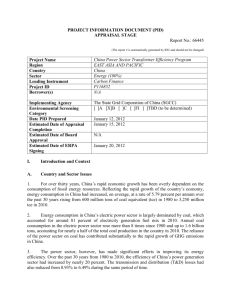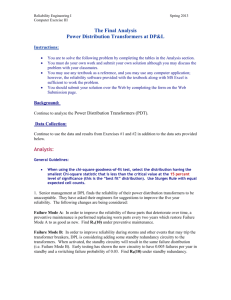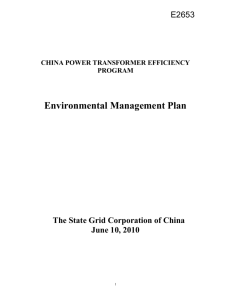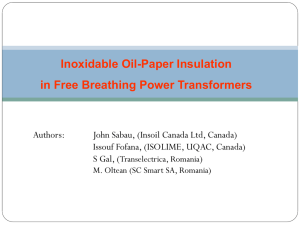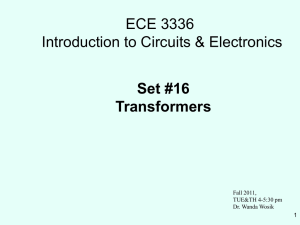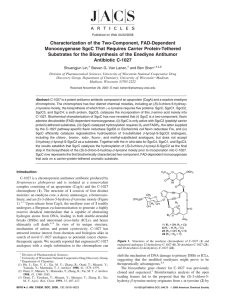INTEGRATED SAFEGUARDS DATASHEET APPRAISAL STAGE I
advertisement
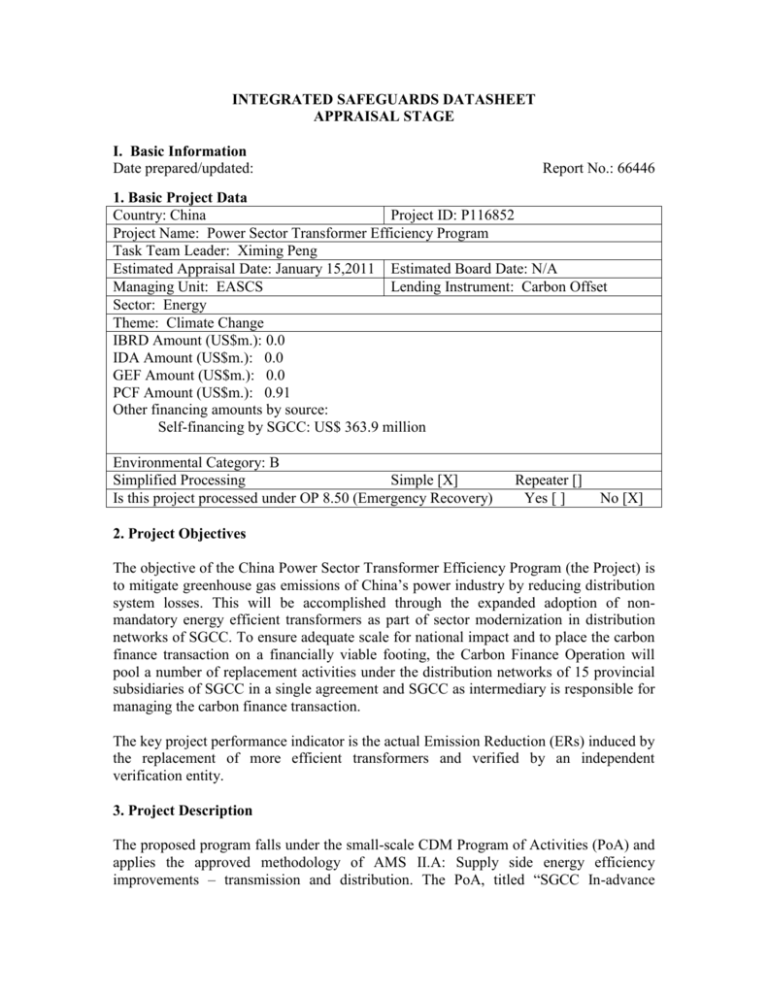
INTEGRATED SAFEGUARDS DATASHEET APPRAISAL STAGE I. Basic Information Date prepared/updated: Report No.: 66446 1. Basic Project Data Country: China Project ID: P116852 Project Name: Power Sector Transformer Efficiency Program Task Team Leader: Ximing Peng Estimated Appraisal Date: January 15,2011 Estimated Board Date: N/A Managing Unit: EASCS Lending Instrument: Carbon Offset Sector: Energy Theme: Climate Change IBRD Amount (US$m.): 0.0 IDA Amount (US$m.): 0.0 GEF Amount (US$m.): 0.0 PCF Amount (US$m.): 0.91 Other financing amounts by source: Self-financing by SGCC: US$ 363.9 million Environmental Category: B Simplified Processing Simple [X] Is this project processed under OP 8.50 (Emergency Recovery) Repeater [] Yes [ ] No [X] 2. Project Objectives The objective of the China Power Sector Transformer Efficiency Program (the Project) is to mitigate greenhouse gas emissions of China’s power industry by reducing distribution system losses. This will be accomplished through the expanded adoption of nonmandatory energy efficient transformers as part of sector modernization in distribution networks of SGCC. To ensure adequate scale for national impact and to place the carbon finance transaction on a financially viable footing, the Carbon Finance Operation will pool a number of replacement activities under the distribution networks of 15 provincial subsidiaries of SGCC in a single agreement and SGCC as intermediary is responsible for managing the carbon finance transaction. The key project performance indicator is the actual Emission Reduction (ERs) induced by the replacement of more efficient transformers and verified by an independent verification entity. 3. Project Description The proposed program falls under the small-scale CDM Program of Activities (PoA) and applies the approved methodology of AMS II.A: Supply side energy efficiency improvements – transmission and distribution. The PoA, titled “SGCC In-advance Distribution Transformer Replacement CDM Programme” (hereinafter referred to as SGCC DT PoA, or the PoA) was registered at the CDM Executive Board on February 12, 2011. This arrangement allows subprojects, individually or as groups, to be added as CDM Program Activities (CPAs) under the PoA on a rolling basis, upon submission of adequate documentation. Monitoring data for activities under each of the programs will be verified periodically by a Designated Operational Entity (DOE) and subsequently undergo certification and issuance by the CDM Executive Board. SGCC has identified about 53,000 inefficient Type 7 and 8 distribution transformers to be replaced with more efficient Type 11 and Type 15 transformers from 2011 to 2016, which are covered by the PoA. Of which about 37,000 transformers will be implemented from 2011 to 2013 and are included in the Project. These transformers are operated at 6 kV and 10 kV, a low voltage level managed by SGCC. The yearly implementation plan is illustrated in Table 1. Table 1. Replacement Plan by SGCC under the PoA the Project 2012 2013 2011 Subtotal 2014 CPA #1 1,100 1,100 CPA #2 5,094 12,782 17,876 CPA #3 13,067 13,067 CPA #4 5,834 5,834 CPF etc. 5,888 Total 6,194 25,849 5,834 5,888 37,877 Cost Estimate (US$ million) 48.2 251.2 64.4 65.2 363.9 Note: Implementation period of the PoA is from 2011 to 2016. Source: SGCC post-2013 2015 2016 Subtotal 4,742 4,742 5,256 5,256 15,886 15,886 51.7 58.0 174.9 Total investment: This Project involves early retirement of around 37,000 low efficiency Type 7 transformers in 15 provincial distribution networks of the country. On average the total investment (inclusive of purchase of equipments, installation, and pre-operative expenses) ranges from about US$ 3,676 for a Type 11 transformer to around US$ 5,882 for a Type 15 distribution transformer. The cohort of high efficiency transformers to be included in the program is expected to mainly comprise type 11 and type 15. The total capital investment of the Project is estimated at US$ 363.9 million. Sources of Funding: The SGCC is responsible for arranging the source of financing of the subprojects. Program financing is derived 100 percent from equity financing. The financing for the first CPA of 1,100 high efficiency distribution transformers had been secured from the SGCC by the end of 2009 and the replacement of the first 1,100 high efficiency transformers in CPA#1 was completed by November 2011. The emission reductions from the implementation in 2011 will be credited on retroactive basis. Purchase of Emission Reductions. The PoA arrangement allows subprojects, individually or as groups to be added as CPAs under the program on a rolling basis, upon submission of adequate documentation. Total four CPAs are planned under the Project. Monitoring data for CPAs under the program will be verified periodically by a Designated Operational Entity hired by the Bank, and subsequently undergo certification and issuance by the CDM Executive Board. The World Bank, acting as Trustee of the Spanish Carbon Fund (SCF), will purchase the successfully Certified Emission Reductions (CERs) through a single Emission Reduction Purchase Agreement (ERPA). The quantity of CERs to be contracted is estimated to be 85,000 tons of carbon dioxide equivalent (tCO2e). generated from 2011 to 2013. The estimated value of the purchase is approximately US$ 0.91 million. 4. Project Location and salient physical characteristics relevant to the safeguard analysis The project activities would be implemented in SGCC’s power distribution grids involving 15 Provinces, municipalities and autonomous regions where SGCC owns and operates the power grids. The project activities will be implemented along selected existing 10 kV distribution lines owned and operated by the SGCC where eligible (eligibility criteria are presented below) inefficient, 10 kV distribution transformers are currently installed, and where the removed transformers will be stored, and dismantled. These places are owned by SGCC or by licensed contractors. No land acquisitions, either permanent or temporarily, are required. Criteria for transformers replacement eligibility are as follows: 6 kV and 10 kV distribution transformers; Type 7 or type 8 Manufactured after 1985 (including 1985) and before January 31, 1999; Free of any current oil leaks or other insulation problems; Located at a site which currently meets environmental, health and safety requirements of the People’s Republic of China and related SGCC environment, health and safety provisions as determined by SGCCs’ due diligence review and; Free of any oils containing polychlorinated biphenyls (PCBs) The new transformers will be required to meet the following criteria: Dry types, modern oil immersed, and/or other modern types of transformers manufactured to meet current related Chinese and related international industrial standards, as well as related environment, health and safety regulations in China S11 efficiency or better Free of PCBs. 5. Environmental and Social Safeguards Specialists Mr. Bernard Baratz (Consultant, Environment), and Mr. Feng Ji (EASCS, Environmental Specialist) 6. Safeguard Policies Triggered Environmental Assessment (OP/BP 4.01) Natural Habitats (OP/BP 4.04) Forests (OP/BP 4.36) Pest Management (OP 4.09) Cultural Property (OPN 11.03) Indigenous Peoples (OP/BP 4.10) Involuntary Resettlement (OP/BP 4.12) Safety of Dams (OP/BP 4.37) Projects on International Waterways (OP/BP 7.50) Projects in Disputed Areas (OP/BP 7.60) Yes X No X X X X X X X X X II. Key Safeguard Policy Issues and Their Management A. Summary of Key Safeguard Issues 1. Describe any safeguard issues and impacts associated with the proposed project. Identify and describe any potential large scale, significant and/or irreversible impacts: Some of the transformers involved are air-cooled. For these transformers, the main issues are minor and short lived: associated with dismantling and disposal of the old transformers (noise, traffic disruption, management of old transformer scrap materialsdisposal, recycle reuse etc.). Some of the transformers are anticipated to be oil cooled. For the oil cooled transformers there are additional issues of managing the waste oils (disposal, reprocessing/reuse) drained from the transformers, and remediation of any land that may have been contaminated from previous transformer oil leaks (transformers that are currently leaking would be disqualified from the project). Disposal of polychlorinated biphenyl’s (PCBs) in cooling oils is not an issue. China never produced oil cooled transformers containing PCBs and agreement has been reached with SGCC that only Chinese made transformers would be eligible under the proposed project. The absence of PCBs in Chinese manufactured oil cooled transformers was verified in 2003 under a separate GEF operation for both Liaoning and Zhejiang Provinces. For the new replacement equipment, there is the minor issue associated with disposal of the non hazardous packing materials in which the replacement transformers are contained. Occupational health and safety (OHS) procedures and emergency preparedness and emergency response (EPR) systems of SGCC were reviewed and found to be satisfactory. There would be no additional requirements for the removal and disposal of the old transformers or for the installation and operation of the replacement equipment. 2. Describe any potential indirect and/or long term impacts due to anticipated future activities in the project area: N/A 3. Describe any project alternatives (if relevant) considered to help avoid or minimize adverse impacts. N/A 4.Describe measures taken by the borrower to address safeguard policy issues. Provide an assessment of borrower capacity to plan and implement the measures described. A comprehensive EMP acceptable to the World Bank was prepared by the SGCC. The EMP will be the primary safeguards instrument and it includes mitigation and monitoring requirements to insure appropriate environmental management for: replacement, storage and disposal of old transformers, (e.g. disposal to approved sites or recycling to permitted reprocessing facilities) for handling and management of scrap materials, and waste cooling oils produced from replacement of the old transformers by licensed/certified operators, and remediation of any oil contaminated soils by licensed remediation specialists and adherence to SGCC procedures for OHS and EPR and management of issues associated with operation of the new transformers. The EMP describes institutional arrangements and responsibilities for environmental monitoring, data analysis, reporting and decision making. The EMP specifies that the transformers to be replaced meet the following criteria: 6 kV and 10 kV distribution transformers; Type 7 or type 8 Manufactured between after 1985 (including 1985) and before January 31, 1999; Under normal operation conditions (without oil leakages or other insulation problems); and In locations meeting the environmental, health and safety requirements of the People’s Republic of China and related regulations of the SGCC. (Note: S7, S8, S11 and S15 are the model numbers of distribution transformers in China, the higher number of the series, the more advance technology and the higher efficiency) The EMP will be the primary safeguard instrument. It includes measures to mitigate soil contamination from transformer leakage and standard SGCC procedures for worker health and safety, emergency response, and environment where appropriate. SGCC has 5 regional power grid companies and 25 provincial electric power companies. Each subsidiary: adopts the SGCC enterprise-level safety, emergency response and environmental protection guidelines into regional-specific guidelines. has a Safety Management Unit (SMU) responsible for the in-field monitoring and enforcement of state, sector and enterprise level safety regulations has an Environmental Protection Unit (EPU), staffed with fully or partially specialized environmental protection personnel, centrally manages the environmental protection efforts within the subsidiary. 5. Identify the key stakeholders and describe the mechanisms for consultation and disclosure on safeguard policies, with an emphasis on potentially affected people. Public consultation was conducted on July 8, 2009 in Beijing and on July 9 and 10, 2009 in Shenyang City of the Liaoning Province where subprojects have been identified for CPA #1. Before the public consultation, an announcement was posted in the State Grid News, on June 25, 2009. The State Grid News is an accredited newspaper publicly issued both paper and internet editions in China and the newspaper covers all the project areas. Representatives of the SGCC (implementing agency), government (the Ministry of Environment), affected communities, manufacturers and academics participated in the public consultation. B. Disclosure Requirements Date Environmental Assessment/Audit/Management Plan/Other: Date of receipt by the Bank 06/11/2010 Date of "in-country" disclosure 11/18/2010 Date of submission to InfoShop 01/20/2011 For category A projects, date of distributing the Executive NA Summary of the EA to the Executive Directors * If the project triggers the Pest Management and/or Cultural Property, the respective issues are to be addressed and disclosed as part of the Environmental Assessment/Audit/or EMP. NA If in-country disclosure of any of the above documents is not expected, please explain why: C. Compliance Monitoring Indicators at the Corporate Level (to be filled in when the ISDS is finalized by the project decision meeting) OP/BP/GP 4.01 - Environment Assessment Does the project require a stand-alone EA (including EMP) report? If yes, then did the Regional Environment Unit or Sector Manager (SM) review and approve the EA report? Are the cost and the accountabilities for the EMP incorporated in the credit/loan? The World Bank Policy on Disclosure of Information Have relevant safeguard policies documents been sent to the World Bank's Infoshop? Have relevant documents been disclosed in-country in a public place in a form and language that are understandable and accessible to project-affected groups and local NGOs? All Safeguard Policies Have satisfactory calendar, budget and clear institutional responsibilities been prepared for the implementation of measures related to safeguard Yes, EMP Yes Yes Yes Yes policies? Have costs related to safeguard policy measures been included in the project cost? Does the Monitoring and Evaluation system of the project include the monitoring of safeguard impacts and measures related to safeguard policies? Have satisfactory implementation arrangements been agreed with the borrower and the same been adequately reflected in the project legal documents? Yes Yes D. Approvals Signed and submitted by: Name Task Team Leader: Environmental Specialist: Social Development Specialists Ximing Peng Bernard Baratz and Feng Ji NA Date 12 January 2012 24 November 2011 NA Approved by: Sector Manager Paul Kriss in EASCS. 16 January 2012
